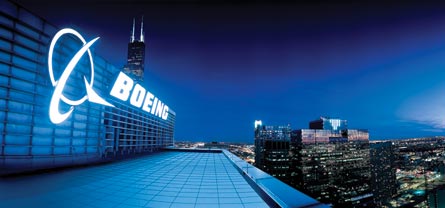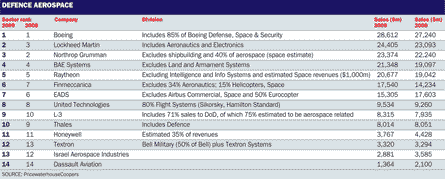Last year Boeing leapfrogged EADS to regain the title of world's largest aerospace manufacturer, as rising sales of its commercial and military aircraft coincided with declines in both areas for its European rival.
In dollar terms, the overall picture for the Top 100 manufacturers was one of stable revenues but sharply declining profits, as the fall-out from global economic and financial chaos filtered through.
That is according to the latest Flight International Top 100 survey, compiled in association with PricewaterhouseCoopers and which is based on company returns for the previous financial year.
The 17.3% drop in collective profits compares with growth of 7.8% in 2008 and 26% in 2007. Where sales edged up only 0.6% last year, they had grown by 7.1% in 2008 and by 13% in 2007.
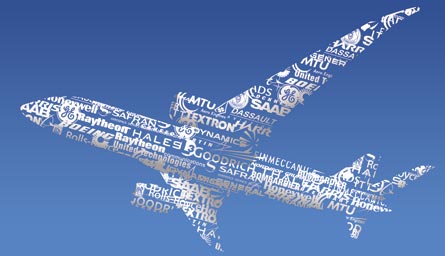 |
|---|
Profile: Fuji Heavy Industries
SALES BY SECTOR
The rivals' fortunes in commercial aircraft manufacture were a major factor in Boeing's eclipse of EADS. In 2008, Boeing's haul from this sector was $10.5 billion less than that of its EADS-owned rival Airbus, but 2009 brought a narrowing of the gap to $2.6 billion (see table).
Boeing delivered 481 aircraft, a steep increase on 2008's figure of 375, which was heavily affected by the 52-day machinists' strike of that year. "It's not so much that EADS won last time; Boeing lost," comments Anna Sargeant, assistant director, strategy at PricewaterhouseCoopers.
"This time round, we're seeing a rebalancing. While EADS hasn't been doing particularly well in defence, I wouldn't say this has been the fundamental driver for that change in position," she says.
Sargeant makes the case that the machinists' strike in some ways helped Boeing. "We were all expecting to see a massive fall-off in production last year - and it never really came, which was impressive."
However, delays to Boeing's 787 delivery schedule will cause the airframer to incur penalty charges. The last programme delay caused the first delivery of the Dreamliner to launch customer All Nippon Airways to slip from the last quarter of this year to the middle of 2011's first quarter.
In 2009 Airbus delivered a record 483 commercial aircraft, 15 more than in 2008. The two major airframers' combined delivery total similarly scaled new heights, exceeding by 7% the previous record of 914 shipments, set in 1999.
Boeing's defence, space and security division meanwhile pulled in some $10 billion more than EADS's equivalent businesses could muster while coping with delays to the Airbus A400M military transport and the attendant contractual wrangle.
There were tough times for regional jet manufacturers. Bombardier Aerospace's revenues shrank 6.1%, while Embraer's were down a whopping 20.5%. The performance of business jet manufacturers contrasted sharply and unflatteringly with that of 2008. Sales at Dassault's Falcon executive jet division grew just 0.2%, compared with 31.4% the previous year. Gulfstream swung from 14.2% growth to a 6.2% decline. Cessna's reversal in fortunes was even more dramatic, as it followed 13.2% growth with a 41.4% decline. Hawker Beechcraft also slipped into decline, with revenues falling 10%.
The scale of declines among business jet manufacturers means that major restructuring is inevitable in that sector, in Sargeant's view.
The defence aerospace sector fared better. Its growth was well above that of the Top 100 as a whole. This represents a change from 2008, when defence aerospace growth was slightly below that of the Top 100.
"This points to declines hitting civil aerospace more strongly," says PricewaterhouseCoopers, which also notes "lower volatility" in defence air systems procurement.
In 2009, the top 14 defence aerospace divisions or companies grew 4%, compared with 0.6% of growth for the Top 100. In 2008, the top 15 defence players achieved growth of 6%, while the Top 100 was up 7%.
Growth at the major US defence companies Boeing, Lockheed Martin and Northrop Grumman was around 5%. However, European defence behemoth EADS suffered a 13.1% decline as growth slowed at the Eurocopter rotorcraft division while both Airbus Military and the Defence and Security Systems division suffered declines. In 2008, EADS's defence aerospace business had grown by an extraordinary 47%.
|
|---|
STRANGE CURRENCIES
As usual, the figures in the Top 100 analysis have been "dollarised" on a fixed exchange rate for the entire 12 months, to reflect the reality that the US dollar is the prime currency of aerospace sales globally, notwithstanding some substantial defence business that is transacted in local currency.
Sterling's weakening against the dollar, from £0.54 per dollar to £0.64, was such that Rolls-Royce's sales could rise by 10.5% in local currency but fall by 7.1% in dollar terms, while the various effects of the euro's fall in value, from €0.68 per dollar to €0.72, included an amplified decline at EADS and constrained growth at Finmeccanica.
Depreciation of the Swedish kroner and Indian rupee turned local currency sales growth of 3.6% at Saab and 10% at Hindustan Aeronautics into dollar declines of 10.8% and 1.3% respectively.
However, foreign exchange effects brought some good news for Japanese manufacturers. Aerospace sales fell in yen terms, but increased in dollar terms at Ishikawajima-Harima, Kawasaki Heavy Industries and Mitsubishi Heavy Industries. The strong yen also helped to boost Fuji Heavy Industries' rise up the rankings (see profile).
However, in considering currency effects one must bear in mind that, across different companies, there is a varying correlation between the currency of a company's main domicile, in which a high proportion of costs will be measured, and the currency in which the bulk of its sales contracts is denominated.
Even within companies, there are variations. In its military business, Rolls-Royce has as a major customer the UK Ministry of Defence; its civil contracts tend to be in dollars. Airbus, with its euro cost base, also tends to yield dollars. "For all of these players, it really depends who their customers are," says Sargeant.
It is also worth noting that exchange rates will have fluctuated across the year, with the result that a contract's particular timing within the year is significant.
As ever the Pareto rule applies to this year's Top 100, with the top 20 companies racking up about 80% of sales and profits - to be more precise, 79% of the former and 78% of the latter. Average margin was lower for the top 20 than the Top 100, but variability in margin was higher among tier two and three suppliers than among tier ones.
MOVERS AND SHAKERS
Collectively, the Top 100 pulled down revenues of $558 billion. The 49 North American companies in the ranking accounted for 63% of this, or $352 billion. Their average operating margin, meanwhile, was 10.4%, similar to the comparable figure for 2008.
The Top 100's European contingent, numbering 38 companies, accounted for $177 billion of revenues, or 32% of the Top 100 total, compared with $206 billion (35%) in 2008. Notably, its average operating margin slumped, from 8.1% in 2008 to 4.7% last year. Given that most European companies will have largely euro cost bases and dollar sales, movements in the exchange rate are likely to have played a significant role in this result.
However, the composition of the top five companies by profit margin precisely mirrored that of 2008, with TransDigm in the top spot, ahead of FLIR Systems, Precision Castparts, Garmin and Hindustan Aeronautics. The only change was that Precision Castparts moved ahead of Garmin.
Generally, the highest margins were to be had in aftermarket-rich businesses, evidenced not just by the performances of TransDigm and Precision Castparts but by those of Chemring and Meggitt.
Electronics was another sector offering profit potential, with Rockwell Collins and Harris joining FLIR and Garmin among the prospering elite. As ever, specialising in a niche could shield a player from competition and boost profit potential.
However, general profitability was back to 2005 levels after five years of steady growth (see graph). In 2009 the Top 100's average margin was 8.5%, down from 9.1% in 2008. That 2008 figure in turn matched the figure for 2001. Subsequently, average margin dropped as low as 6.9% - in 2003 - before its five consecutive increases.
Aside from energy control systems specialist Woodward Governor - which, having acquired MPC Products and HR Textron, grew revenues by two-thirds - the Top 100's fastest-growing company, based on aerospace sales in local currency terms, was Norway's Kongsberg (see profile).
GKN was not far behind, increasing aerospace sales by almost a half after acquiring Filton Aerostructures from Airbus in January 2009. After boosting its ranking by seven places in 2008, Chemring (see profile) repeated the trick last year, with aerospace growth exceeding 40%.
BAE Systems' sales grew by one-third as it continued its acquisitions drive. After purchasing MTC Technologies, Tenix Defence and Detica in 2008, it added unmanned air vehicle specialist Advanced Ceramics Research last year. Its ranking slipped three places only because of a reclassification of its land and armaments division.
In addition to being among the fastest growers, BAE Systems was also in the top five when it came to absolute growth, as measured by added revenues in dollar terms. Boeing topped this table too, ahead of Finmeccanica, which grew aerospace sales by one-fifth, and the defence giants that took third and fourth place in the rankings - Lockheed Martin and General Dynamics. Lockheed's sales rose $2.5 billion. General Dynamics grew its revenues by $2.7 billion, in the process jumping two places in the rankings.
After achieving the highest growth of any Top 100 company in 2008, French aerostructures and cabling specialist Latécoère suffered the sharpest contraction in 2009, with its sales dropping by more than one-third as it bore the impact of Boeing 787 delays, delivery slowdowns at Embraer and Dassault, and a dispute over a business jet contract.
Indicative of the continuing consolidation of aerospace manufacturing, Hampson Industries managed to re-enter the Top 100 despite its aerospace sales falling by almost 30%, a figure affected by its disposal of Hampson Aerospace Machining.
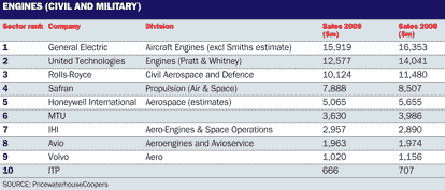
CHART PLACINGS
While Boeing moved past EADS, five other companies in the top 20 also improved their positions. General Dynamics and Raytheon each jumped two places, to fourth and sixth place respectively. GE and Rolls-Royce each rose one place, with the former in 10th position and the latter in 14th.
These progressions were at the expense of Thales, Textron, Northrop Grumman and BAE. Thales dropped five places to fifteenth after a reclassification of revenues to exclude the security division, which is not involved in aerospace manufacturing. Northrop slipped one place to fifth and Textron by one place to seventeenth. As mentioned, a reclassification affected BAE's placing.
Elsewhere in the Top 100, the rising stars were Woodward Governor (up to 70 from 91), Kongsberg (54 from 66), FLIR (73 from 85), Chemring (68 from 75), Fuji Heavy Industries (58 from 65), Diehl (93 from 100), SKF (82 from 87), Loral Space & Communications (59 from 64), Amphenol (74 from 79) and Kaman (83 from 88; see profile).
Latécoère's diving sales brought a slide in the rankings, to 76 (from 60 in 2008). There was an even harder landing for Firth Rixson, which limped in at 86 after being placed at 69 the previous year. Elsewhere, there were significant diminutions of status for Sequa (64 from 55), Hexcel (which completed Fuji's journey in reverse, moving to 65 from 58), PAIG (85 from 78) and BBA (46 from 40).
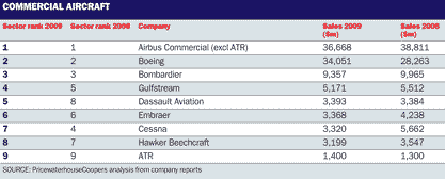
MERGER RE-EMERGENCE
"There was limited merger and acquisition activity from financial investors in 2009," says PricewaterhouseCoopers, which notes a prevalence of "uncertainty, particularly in commercial aerospace". Nonetheless, there was "a notable number" of transactions by corporate players, with US companies dominating among both acquirers and targets, although European players seeking dollar-zone presences were also active as acquirers.
In July 2009, Boeing acquired the assets and operations of Vought Aircraft Industries' South Carolina facility, where aft fuselage sections for the 787 are fabricated and stuffed. The rest of Vought Aircraft Industries was acquired by Triumph in June, a transaction falling outside the timeframe relevant to this year's Top 100.
In December, Boeing continued its efforts to regain control of the delay-hit 787 programme by purchasing from Alenia Aeronautica the outstanding 50% of Global Aeronautica, which integrates centre fuselage sections at a facility also in South Carolina.
EADS, meanwhile, pursued transactions aimed at boosting its presence in the rotorcraft market. In April 2009 it took an 80% stake in Euroheli and in October it purchased 60% of All Nippon Airways' helicopter maintenance business.
The company placed third in the Top 100, Lockheed Martin, was not inactive when it came to takeovers. It acquired Universal Systems & Technology, which provides interactive training and simulation services, in January 2009. Gyrocam Services, a manufacturer of gyrostabilised optical surveillance systems, joined the Lockheed empire in August.
The unmanned air vehicle market was a target for a number of prime contractors. Northrop Grumman acquired the design rights to Swift Engineering's KillerBee product line in May 2009. The following month, BAE moved to extend its UAV reach by buying Advanced Ceramics Research.
Raytheon's move up the charts was aided by its acquisition, in October, of BBN Technologies, a provider of command, control, communications and intelligence (or "C3I") systems. GKN, another chart riser, acquired Filton Aerostructures from Airbus in January 2009, going on to win additional work packages on the Airbus A350 XWB and the Joint Strike Fighter.
As M&A activity continues to pick up, some important questions arise, as identified by Sargeant: "At what point is there going to be a serious investment made into Asia? And what's going to be the game-changing development which makes that happen? It's something that's been on the horizon for a number of years now, but we haven't seen significant investments." The ramp-up of activity at Airbus China may serve as a catalyst to increased investment in the wider region.
Generally, corporate investors will continue to pursue acquisitions as a means of accessing growth markets while financial investors will target niche companies with higher profit potential, predicts Sargeant.
"There are a number of funds which have already been raised but are looking for the right investment - and some players who are able to make investments with almost 100% equity," she notes. "And then there are players looking to exit."
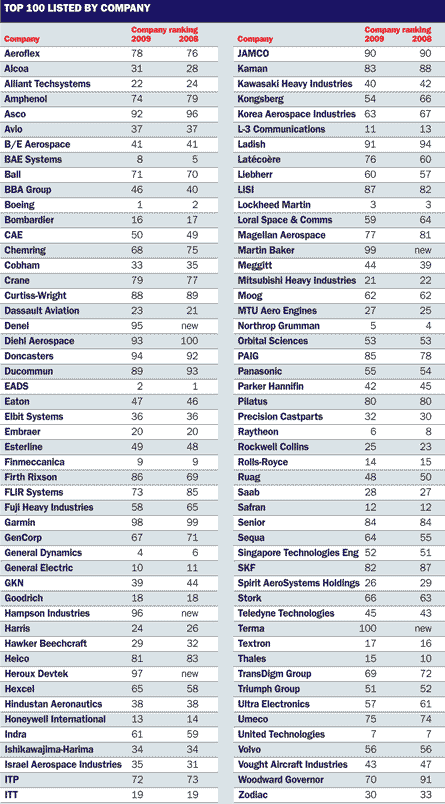
THE BIG PICTURE
Overall, 2009 was "a challenging year for the global aerospace industry", says PwC. Reduced passenger and air freight demand brought a dramatic decline in new aircraft orders as airlines looked to preserve cash. Military and commercial programmes - including the Airbus Military A400M and Boeing 787 - were afflicted by delays and cost overruns.
Credit markets, meanwhile, remained tight. Compared with its civil counterpart, the defence sector remained relatively robust, an outcome PwC attributes to "reliance on public sector funding". However, large military platforms garnered fewer orders, reflecting "a shift in the defence strategy away from previous large-scale heavy programmes to more intelligence-based and intelligence-support programmes", says PwC.
"Companies were adapting to adjustments in defence procurement to focus even more on flexible, mobile and responsive force structures, with an increasing focus on logistics and life-cycle support," adds the consultancy.
Amid uncertainty over the future outlook for civil aircraft demand, Airbus and Boeing managed their orders carefully, PwC suggests. The airframers avoided sharp declines in delivery numbers, but put production ramp-up plans on hold.
Meanwhile, the airframers' efforts to reorganise their supply chains around fewer suppliers continued. "The increased prevalence of risk- and revenue-sharing partnerships meant that their supply chains were more exposed to changes in delivery profile than ever before," says PwC.
That regional and business jet manufacturers were not able to manage the volatility in their markets as easily is reflected in declines approaching 40% for those worst affected.
For defence aerospace's prime contractors, meanwhile, diversification into unmanned technologies represents a means of mitigating risk on core air systems programmes.
|
|---|
A BRIGHTER FUTURE?
When looking to the likely outcome of this year, PwC sounds a note of optimism. "As global economies recover, we are seeing a return to airline demand growth in 2010," says the consultancy, noting decisions made by Airbus and Boeing to ramp up production of narrowbody aircraft.
In the widebody sector, meanwhile, a rethink is under way. "Boeing and Airbus are being forced to reconsider the best way of delivering large programmes," says PwC. "The strategy of outsourcing and joint ventures favoured for so much of the last decade is being questioned as they try to exert supply chain discipline and control."
In the aftermarket business, prospects have been boosted by increased aircraft utilisation, even if the recession has expedited the exit of older types requiring heavier maintenance. Maintenance deferred during the downturn will finally be carried out. However, the maintenance industry's centre of gravity is likely to shift, since airline growth is focused in Asia, the Middle East and Africa.
As the commercial market picks up, the outlook for defence aerospace grows cloudier amid intensifying pressure on the US and UK defence budgets, and indeed on public spending generally. The upshot, by PwC's reckoning, is that governments are using "new methods to develop, acquire, finance and support defence equipment".
For defence suppliers, there is a need to rethink supply chains and "explore cross-national synergies", according to the consultancy. "The activity in the security, surveillance and homeland security sectors is likely to continue as suppliers invest in growth areas away from the traditional defence budgets," it says.
Nevertheless, the US Quadrennial Defense Review, issued in February, and the US defence budget for fiscal year 2011 have eliminated some of the uncertainty regarding that nation's defence spending priorities, and this has enabled strategic decisions to be taken.

UNMANNED SECTORS
Increased interest in the support and unmanned sectors can be discerned among many defence players. In the UK, the industry anxiously awaits the outcome of the Strategic Defence and Security Review, which is due in October. Meanwhile, desire to limit exposure to home markets' defence budgets is evident, for example, in the priority afforded by BAE Systems to the Indian market.
While 2010's overall results are likely to be "stable with some growth, it's a really a question of what strategic moves companies make in order to deal with changes coming down the pipe in the defence market", says Sargeant.
She sees profitability as likely to increase, but cautions that fluctuating exchange rates will continue to have an impact. Equally, the now well-established prevalence of risk-sharing partnerships means that any volatility at Airbus and Boeing will reverberate through their supply chains. "That's a big change companies are having to deal with," she says.
At the same time, companies are likely to be "more savvy" when it comes to negotiating future risk-sharing partnerships, says Sargeant. This applies not just to suppliers but the primes too. "The prime contractors are recognising that if they pass too much risk to their supply chain, then it's actually the prime contractor that will feel the pain in the end."

Source: Flight International

















